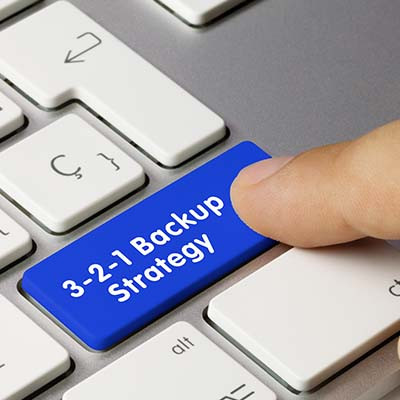When it comes to your business’ data backup and disaster recovery, you want to have clear outcomes that you aim for, as well as metrics that help you gauge success. Today, we want to highlight some of the most important metrics associated with data backup and disaster recovery, as well as the importance of testing your systems. Trust us when we say that a solid data backup and disaster recovery strategy is crucial to the success of any business—including yours.
Computerware Blog
Every year on March 31st, World Backup Day serves as a dedicated occasion to emphasize the crucial role of regular data backups in ensuring the seamless continuity of information. While this awareness day effectively underscores a fundamental best practice, we staunchly advocate for an ongoing commitment to continually maintaining and protecting backups, extending beyond the confines of a singular day.
Tape backup has been used for a long time, and it was once the most prominent solution for data backup out there. Nowadays, it’s not used much at all, mostly in favor of better and more convenient solutions. However, there has been a slight resurgence in tape backup, so we want to look at why some companies might still use it, despite its flaws.
Data and technology drive modern business, and as such, data backup and disaster recovery are crucial to the continued success of any organization. There is so much at risk that it would be counterproductive to ignore these unforeseen disasters. Disaster Recovery as a Service, or DRaaS, is an effective way to combat the omnipresent threat of data loss.
In order to protect your organization’s important digital assets you need to build something that you spend most of the time trying to avoid in every other facet of your business, building redundancy. Redundancy is seen as wasteful in most situations, but with your data being so important to your business, ensuring that you have duplicate copies of it is essential.
Technology is center-stage in today’s business world, and when all it takes is a disaster to end operations for many businesses, it suddenly becomes incredibly important to have contingency plans in place… you know, just in case. Let’s go over how you should build an effective disaster recovery plan, as well as how to assess your company’s needs.
Data Backup and Disaster Recovery are essential components of any modern business. As businesses become increasingly reliant on digital data, it's essential to have strategies in place to ensure that your data is safe and secure in the event of a disaster. In this blog post, we'll cover the key components of an effective Disaster Recovery strategy to ensure the safety of your business' data backup. Read on to learn more about Disaster Recovery strategies and how to best protect your business data.
Modern businesses are undergoing digitization at an impressive rate, but many still haven’t grasped the benefits of this digitization. In short, the average business that underwent these shifts suddenly had double the data at their disposal to use and manage. If you feel as though you haven’t done so, here are a few business areas that properly using your business’ data can significantly improve.
Business continuity is one subject that not a lot of people know a lot about. Even those that claim to, often only understand the theory behind it and the practical applications of strategies and procedures necessary to keep a business running smoothly. This is largely because there isn’t a curriculum that presents a comprehensive outline on how to deal with disaster. This month, we’re going to share some continuity strategies that work, regardless of the situation, to get your business coordinated and back up and running fast following an unfortunate event.
While we might like to think that all computer problems are an easy fix, there is only so much you can do in certain circumstances. That being said, having a couple of computer maintenance “hacks” under your belt can make things loads easier for you when you do have to get your computer repaired. Here are some tips to consider before it’s time to get your computer repaired.
We often use the term “redundant” to describe technology, and it’s easy to see this word and think about it in a negative way. However, in business technology, the exact opposite is true, and redundancy is widely seen as not just an important component of any successful IT strategy, but a critical one. What does redundancy mean to your business technology, and how can you make sure you implement it in the appropriate way?
Disasters can happen when you least suspect them. Whether it’s a tornado that levels your office or an electrical failure which sparks a structural fire, a business-ending scenario could happen with little-to-no warning. You must be prepared to maintain operations even when it feels impossible, and part of this is being prepared to handle off-site operations.
In today’s age of ransomware, climate change, and worldwide pandemics, a lot can happen that could spell trouble for your organization. This is why it is so critical for your company to have a business continuity plan. There are many factors that contribute to a successful business continuity plan, one of which is a disaster recovery plan. But wait, aren’t those the same thing? Not quite.
Data backup is one of the most important parts of protecting your digital assets, but many organizations are unable to successfully pull it off without a hitch. We’ll help you get a feel for what should happen when you set up your data backup system, what happens when you initiate a backup, and how to proceed with restoring it.
One of the best investments you can make in your IT infrastructure is implementing a data backup and disaster recovery solution. Not only is it a crucial part of any business continuity plan, but it also helps to future-proof your business in the event of a potentially disastrous scenario. There are three big reasons why you should consider implementing data backup and disaster recovery, and if you fail to do so, you are putting your company at risk for no real reason.
If you were to lose your business’ data, would you be able to continue operations? Usually not. This is why you need to take precautions before you inevitably suffer from an unpredictable situation that puts your data at risk. Unfortunately, the average small business might not think they are at risk, a notion we are trying to dispel. If your organization is considering backup and disaster recovery, we want to help you better understand data redundancy.
For any business continuity strategy to be complete, a data backup strategy needs to be involved. This is often easier said than done: there are a lot of elements that need to be considered, and some data can go overlooked if the solution isn’t maintained. However, considering the likelihood of data loss without one, a data backup is an indispensable component to prioritize and evaluate over time.
If you’re at all familiar with us, you’re probably aware of how highly we rank data backup. If your business creates or stores any data (which we guarantee it does) you need to have a backup to protect it, as simple as that. Let’s take a few moments to review how a BDR (Backup and Disaster Recovery) can benefit your business and its long-term continuity.




















